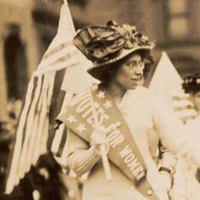Constitution helps define women’s civic membership and creates social roles
Chile, Germany, the Philippines and Liberia. What do these countries have in common? A woman holds the top political office in each country.
Now, name five female politicians in the United States government—other than Hillary Rodham Clinton or Condoleezza Rice. Having trouble?
Americans take pride in living in a country that treats all citizens equally. Schoolchildren discover phrases like “We, the People” and “all men are created equal” as they learn about the founding fathers, democracy and the Constitution. But who exactly are “We, the People”?
In her book, “The Constitution as Social design” (Stanford University Press, 2006), Gretchen Ritter, director of the Center for Women’s and Gender Studies and associate professor of government, argues women’s struggles to gain equality are both inspired and constrained by our understanding of the Constitution and the social roles it creates.
“The process of writing and adapting the Constitution is really a process of distinguishing who belongs to our political community, and on what terms,” Ritter says. Women’s equality day in august commemorates the adoption of the 19th Amendment in 1920. With the passage of this groundbreaking piece of legislation, women earned the right to vote and were welcomed as rights-bearing members of the political community. yet, the exact terms of their membership have yet to be settled.
Public selves and Private Lives
Women’s fight to participate in politics dates back to the 1848 Seneca Falls Convention, where Elizabeth Cady Stanton and other feminist luminaries wrote the Declaration of Sentiments. The document, modeled after the Declaration of Independence, called for equal treatment of women and men under the law, and voting rights for women.
When the 19th Amendment was adopted more than 70 years later, it did not produce the radical change women sought.
At that time, the dominant perception of women’s citizenship was what Ritter calls the domestic-dependent ideal. Women were represented in the public realm by their husbands or fathers. A woman’s civic membership was defined by her private life, and her roles as a wife and a mother.
“Women really hoped that by getting the vote, they would get equal citizenship, and that just didn’t happen,” Ritter says. “The old way of thinking that women’s citizenship was defined by their marital status still had a lot of power. Women were regarded as citizens and individuals when it came to voting, but when it came to things like property and work rights, they were still considered to be dependent on their husbands.”
While the domestic-dependent ideal is highly restrictive, Ritter says it is not entirely negative. It provides a way of recognizing that women’s home lives and family relationships matter to their politics. Some remnants of this ideal remain in modern society. For example, the government provides assistance to women based on the contributions their husbands made as soldiers or workers.
“It’s saying, because of his contribution, we’re going to recognize and protect you as his dependent,” Ritter observes.
